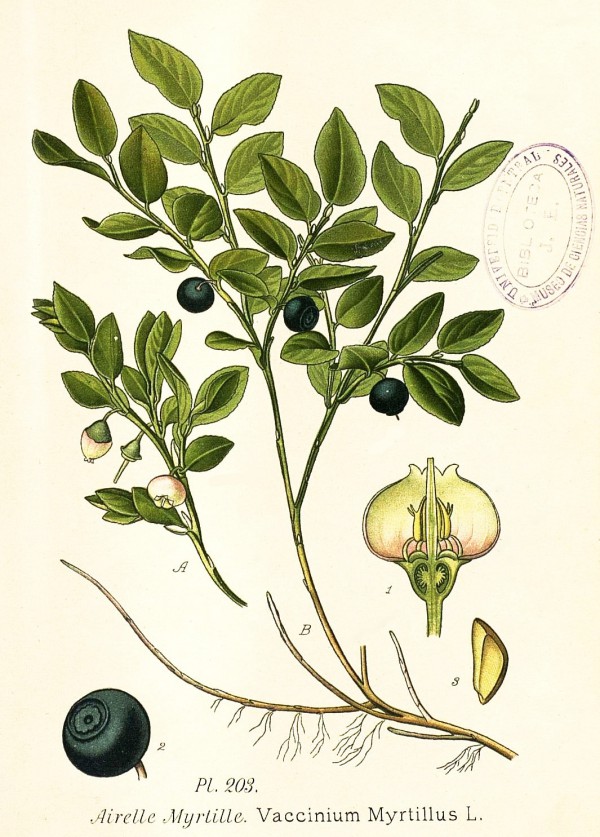Vaccinium myrtillus L. - Ericaceae - bilberry, whortleberry, European blueberry, Heidelbeere, Blaubeere
Summergreen erect shrub, 15-50cm high, native to Eurasia, northwestern North America; twigs with edges, green; leaves ovate, serrulate, pale green; flowers green-red; fruits blue to black.
„The volatile components of bilberry, bog blueberry and cultivated high-bush blueberry (cv. Rancocas) were analysed by gas chromatography and mass spectrometry. Several new compounds not reported previously as blueberry volatiles were detected. These included methyl and ethyl 2-hydroxy-3-methylbutanoate, methyl and ethyl 3-hydroxy-3-methylbutanoate, 2-phenylethyl formate, methyl salicylate, farnesol, farnesyl acetate, vanillin, myristicine, 4-vinylphenol, 2-methoxy-5-vinylphenol, citronellol, hydroxycitronellol and some γ- and δ-lactones. The character impact compounds of bilberry were found to be the above-mentioned hydroxy esters together with 2-phenylethanol and its esters and the γ- and δ-lactones, whereas myristicine, citronellol, hydroxycitronellol, farnesol and farnesyl acetate were typical of the aroma of high-bush blueberry.“
[The aroma of blueberries., Hirvi, T., Honkanen, E., Journal of the Science of Food and Agriculture, Vol.34(9), 1983, 992-996]
Of the 35 odor-active compounds detected by applying AEDA on the liquid ectract of blueberry, highest FD factors showed ethyl 2-methylbutyrate (green, slightly apple-like), hexanal (fatty green, grassy), octanal (orange fatty), isothiazole (skunk, sulfury), octen-3-one (mushroom), (E,E)-2,4-heptadienal (fatty, green, greasy), and (E,E)-2,4-decadienal (deep fatty, slightly citrus note). The esters (methyl butyrate, ethyl isobutyrate, methyl isovalerate, ethyl 2-methylbutyrate, and ethyl isovalerate) with fruity and floral notes gave FD factor 4. The same FD factor of 4 had alcohols like isoamyl alcohol, octanol, and decanol as well as linalool oxide and isovaleric acid. Sulfur compounds like dimethyl sulfide (FD 7), thiazole, isothiazole, dodecyl mercaptan, ortho-methylthio phenol (FD 4), and 1-p-menthene-8-thiol (FD 1) also seem to contribute to the aroma of blueberry. Other characteristic floral, tea like, and spicy notes with low FD factor were damascenone, β-damascone, phenylethanol, α-methylionone, and cinnamic aldehyde.
[Hanoglu A., Pucarelli F. „Recent Highlights in Flavor Chemistry & Biology. 8th. Deutsche Forschungsanstalt für Lebensmittelchemie; Garching, Germany: 2007. Determination of key aroma-active compounds by GC-O Aroma Extract Dilution Analysis (AEDA) in cranberry and blueberry fruits“ Proceedings of the 8th Wartburg Symposium on Flavor Chemistry and Biology, Eisenach, Germany. 2007, 269-275]
„… HS-SPME analyses revealed complex volatile profiles including terpenes (23 compounds, e.g. p-cymene, 1,8-cineole, linalool) and aromatic structures (10 compounds, e.g. benzaldehyde, ethyl benzoate, 2-phenylethyl acetate, benzyl benzoate), which contribute to the characteristic and flavourful blueberry aroma… The most abundant compounds were related to the group of C6-structures or so-called ‘green leaf volatiles’… In addition, impact-aroma compounds belonging to the chemical group of monoterpenes, could also be extracted from all samples, e.g. 1,8-cineole, linalool, and linalyl acetate.“
[Volatile profiles of European Blueberry: few major players, but complex aroma patterns., Rohloff, J., Nestby, R., Nes, A., Martinussen, I., Agronomijas Vēstis, Vol.(12), 2009, 98-103]
https://llufb.llu.lv/conference/agrvestis/content/n12/Latvia-Agronomijas-Vestis-12-2009.pdf
„Fruits and fruit extracts are recommended for treating diarrhea, especially in children. They are used locally to treat inflammation of the mucous membranes of the mouth and throat…The main active ingredients are mosytly catechol tannins (up to 12%) and proanthocyanidines…
The leaves are no longer recommended because prolonged use seemed to have toxic side effects… “
[Medicinal Plants of the World. Ben-Erik Van Wyk and Michael Wink, Pretoria 2004, 333]
Traditionally, to treat diarrhea in children, one let them chew (10g, several times a day) fresh blueberries (Myrtilli fructus recens) or dried ones (Myrtilli fructus siccus).
The leaves (Myrtilli folium) were formerly used to treat diarrhea, kidney problems and inflammation of mouth and troath, but efficacy has not been established. As the leaves contain quinolizidine alkaloids, especially (+) myrtine, prolonged use may have toxic side effects.
[Wolfgang Blaschek ed., Wichtl - Teedrogen und Phytopharmaka: Ein Handbuch für die Praxis, 2015, 443-447]

Masclef, A., Atlas des plantes de France, vol.3, t.203, (1891)
http://plantgenera.org/species.php?id_species=1048469
Vaccinium myrtillus
© Rolf Marschner (2006),
www.botanische-spaziergaenge.at
